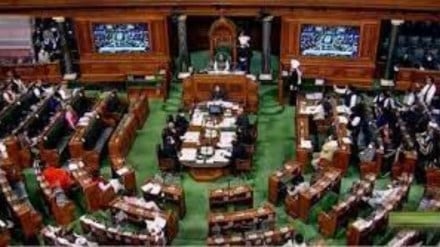No-confidence motion in Parliament: The Narendra Modi government faces its second no-confidence motion in Parliament on Tuesday. Congress and the Bharat Rashtra Samithi (BRS) have submitted two separate notices of no-trust motion against the Narendra Modi government over the ethnic strife in Manipur. The no-confidence motion was accepted by the Lok Sabha speaker Om Birla on July 26.
This will be the second time the Modi government will face a no-trust motion in the Parliament since 2014. The motion was brought to the Lower House by Congress Party MP Gaurav Gogoi amidst the Opposition’s ongoing protests demanding PM Modi’s address on the Manipur crisis.
It will also be interesting to see senior Congress leader Rahul Gandhi back as a Member of Parliament, who is also expected to speak during the debate on the no-confidence debate in the Lok Sabha.
The Lok Sabha business advisory committee has allocated three days for a discussion on the no-confidence motion. Meanwhile, PM Modi is scheduled to speak on August 10.
What is a No-confidence motion?
Under the parliamentary form of government, the no-confidence motion is seen as a test of whether the ruling government enjoys a clear majority in the directly elected house. According to the Constitution, a government is eligible to remain in power only if it has the required numbers for a majority in Lok Sabha.
Article 75(3) of India’s Constitution lays down the provision that the Council of Ministers is collectively responsible to the Lok Sabha. The rules of Lok Sabha have a mechanism called a ‘no-confidence motion’ to test collective responsibility.
How can a no-confidence motion be moved?
Under Rule 198 of the Rules of Procedure and Conduct of Lok Sabha, a member has to move a written notice before 10 am, which will be read out by the speaker within 10 days of the written motion being submitted.
Thereafter, a discussion on the motion takes place and later the MPs have to vote in favour or against the ruling government – in case the motion carries, the government is bound to vacate the office.
Also Read: No-confidence motion in Indian Parliament: History and timeline
Who can move a no-confidence motion?
According to the rules, a Lok Sabha MP needs to garner 50 lawmakers to introduce a no-confidence motion against the government. Subsequently, a discussion on the motion takes place.
How is a confidence motion different from a no-confidence motion?
On the other hand, the Prime Minister can also move a ‘confidence’ motion in order to prove the strength of the government in the Lok Sabha whereas the ‘no-confidence’ motion is a formal proposal by a member against the ruling government.
BJP in trouble over ‘no-confidence’ motion?
No. In the House of the People, where the majority mark is 272, the BJP’s strength alone is 301. This implies that even if the opposition leaders come together, the BJP still has the numbers to survive a no-confidence motion. With NDA allies, the ruling party is expected to sail through this test. The BJP has also issued a three-line whip for its Lok Sabha MPs to be present in the House from August 7 to August 1.
How many govts have fallen to no-confidence motion in Lok Sabha?
This no-confidence motion will be the 28th no-confidence motion in the history of no-confidence motion in India since independence. The first was moved against the government led by Jawaharlal Nehru during the third Lok Sabha in 1963. The motion was moved by former Congress and Praja Socialist Party leader Acharya J B Kripalani.
Out of the 27 no-confidence motion till 2018, three governments have fallen to the motion during the vote of confidence- the V P Singh government in 1990, H D Deve Gowda government in 1997 and the Atal Bihari Vajpayee government in 1999.
